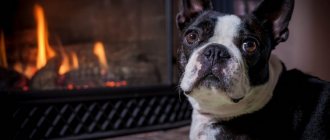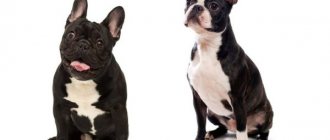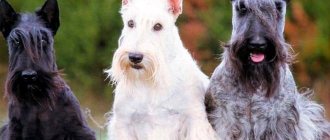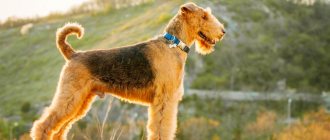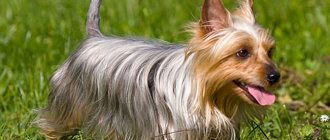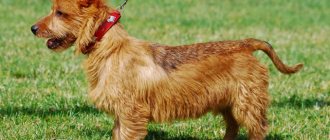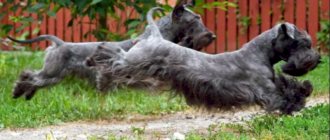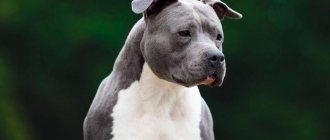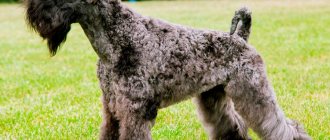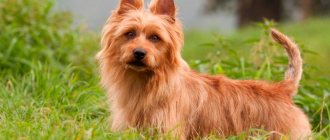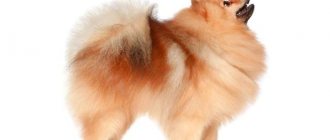History of the Boston Terrier breed
Boston Terrier
The history of the breed began at the end of the 19th century, in America. In 1870, Boston resident Robert Hooper bought an unusual dog from his friend William O'Brien. According to the seller himself, the stocky, strong male was a cross between an English terrier and an English bulldog, which provoked Hooper to make a spontaneous purchase. Without hesitation for a long time, the Bostonian christened his ward Judge and took him to mating with a bitch named Jip, who belonged to Edward Burnett. After the allotted time, Jip gave birth to a cute male dog, named Wells Ef, and an elegant “girl” - Tobin Keith. When the puppies grew up, they were bred first with each other, and then with their parents, thereby laying the foundation for the gene pool of the future breed.
Over the next decades, Massachusetts breeders, including the same Robert Hooper, carried out targeted work to improve the exterior performance of dogs. For example, the first generations of animals were infused with the blood of the Old English White Terrier several times, which helped make their figures less brutal. Gradually, another distinctive feature of the descendants of Judge began to emerge more clearly - the rounded shape of the skull, and therefore the dogs began to be called round-headed bullies. Later the name was transformed into American Bullies, and then into American Bull Terriers - it was under this phrase that the first “Bostons” appeared at exhibitions. This did not last long, as the breeders of the then popular English bull terriers rebelled against the name. Angry owners demanded the immediate renaming of the Massachusetts Mixed Breeds to avoid confusion in defining the breeds. So Judge's descendants became Boston Terriers.
The first club of fans of the breed was formed in its homeland, Boston, in 1889. Two years later, the organization was renamed the American Boston Terrier Club, and a couple of years later it joined the AKC. As for entering animals into stud books, this was first done in 1893, after which Boston Terriers became the most sought-after pets among middle-class Americans. However, already during the Great Depression, the popularity of the breed began to decline. The situation was aggravated by the Second World War, after which dogs began to be imported to the United States from Europe. Nevertheless, the Bostons were never on the verge of extinction.
Mating
Sexual maturity in Boston Terrier bitches occurs at the age of 6-12 months , in cable dogs it is 1.5 months later. However, it is better to breed females at 1.5 years , and males at 2 .
- The first estrus in females begins at 8-12 months . It lasts about 4 weeks . Then estrus will occur every 6-8 months .
- To understand that your pet is in heat, you need to pay attention to her genitals (loops). They will begin to swell and spotting will appear. The animal will urinate more often than usual and lick the loop. Sometimes during estrus heavy shedding begins.
- It is worth paying attention to the color of the discharge. If they are not bloody, then you should consult a doctor, as this may be juvenile vaginitis.
- The pet's behavior changes very much. She will try to constantly be as close as possible and demand a lot of attention.
- You should only walk your dog while in heat on a leash! In this state, she may not listen to the owner and eventually simply run away.
- It is better to breed a bitch during her 2nd heat . The most favorable time for conception is considered to be 7-14 days . This is the ideal time to meet a male dog, as sexual arousal is at its maximum.
- Pregnancy lasts 58-71 days . The closer to birth, the less stress the dog should have. It is better to consult a veterinarian regarding nutrition.
Boston Terrier breed standard
Boston Terrier puppy
The classic Boston Terrier has a bulldog-like flattened muzzle, splayed front paws, combined with a muscular body and rapid movements. Solid, but proportionally built, this medium-sized “American” is completely devoid of the stockiness and clumsiness of a bulldog, moreover, he does not have folds on his muzzle, unlike his English ancestor.
According to weight categories, Boston Terriers are divided into three classes: less than 6.8 kg; 6.8-9 kg; 9-11.35 kg. The height of the dog at the withers should be equal to the length of the body. “Bostons” have a strong backbone, but do not look rude.
Sexual dimorphism in Boston Terriers is insignificant, so the only thing that distinguishes “girls” from “boys” is a more elegant bone structure and general sophistication of appearance. Boston terriers correspond to the image of stylish “dandies”, which is facilitated by the dogs’ proud posture and unique color, reminiscent of an elegant tailcoat with a snow-white “shirtfront” on the chest.
Head
Boston Terriers are typical brachycephalics with a square, flat skull between the ears and an ultra-short, massive muzzle. The length of the muzzle should not exceed one third of the length of the skull. Representatives of this breed have clearly defined eyebrows and feet, and flat cheekbones. The look is decisive, quick-witted and, at the same time, friendly.
Jaws and teeth
The jaws of Boston Terriers are square, massive, closed in a straight bite (let's say an undershot). The teeth are medium-sized, with incisors located along the same line.
Nose
The lobe is stretched wide, with a well-drawn midline between the nostrils.
Eyes
The correct Boston Terrier has wide-set, rounded, dark eyes. The outer corner is at the level of the cheeks.
Ears
The dog's ears are erect, wide and high set. The standard also allows a cropped ear shape.
Neck
The Boston Terrier's neck is high-set, slightly arched, gently merging into the withers.
Boston Terrier muzzle
Frame
The dog's body is square, but not stretched. The Boston's back line is flat, with a short loin and sloping croup. The chest is wide and quite deep.
Boston Terrier from the back
Limbs
Distinctive features of the front legs of the Boston Terrier are a wide set, oblique shoulder blades, responsible for the grace of the animal in movement, and short, strong pasterns. The dog's hind legs are level, with sloping fleshy thighs, distinct angulations and short and straight metatarsals. The Boston Terrier's paws are tightly knit, with arched toes ending in short, massive claws. Representatives of this breed also have dewclaws, which are best removed in a timely manner. The animal's movements are straightforward, rhythmic, without stiffness.
Tail
The short, thin tails of Boston Terriers are carried straight or curled into a corkscrew and do not rise above the line of the back. The optimal tail length is ¼ of the distance from the croup to the hock.
Wool
The short, glossy coat adheres well to the skin and is practically devoid of undercoat.
Color
The traditional coat colors of Boston Terriers are dark brown (seal), black and brindle, all of which should be diluted with white spots. The standard approves white markings: a wide stripe between the eyes, the outline of the muzzle, a spot that occupies the entire chest. It is highly desirable that the animal have white forelimbs, “collar” and hind legs (not higher than the level of the hocks).
Defects and disqualifying defects
Brown Boston Terrier (liver)
Ideal in exterior terms, “Bostons” are an exceptional phenomenon rather than a widespread one. Usually animals have a couple of defects of varying severity that do not affect health, but prevent the dog from receiving a champion diploma at exhibitions. These are: eyes with visible whites, a skewed lower jaw, large/disproportionately small ears, a tail carried vertically, a back with a sag or a hunchback. Animals with open paws, straightened hocks, waddling and ambling cannot count on excellent marks either.
Disqualifying faults:
- complete absence of white marks on the coat;
- Blue eyes;
- gray and liver colors;
- docked tails;
- light lobes.
Photo of Boston Terrier
Boston Terrier personality
Love
Boston Terrier is a good-natured house clown, making funny faces, fooling around like a child and charging the surrounding space with positive energy. Friendly, restless, ready to give attention to anyone and everyone, he is absolutely devoid of such qualities as aggressiveness and suspicion. So, for example, the Boston Terrier does not care at all who the two-legged creature that appears on the threshold of your apartment actually is - a representative of network marketing or a family friend. This “Massachusetts native” is loyal to any person, as long as he does not violate territorial boundaries or try to use physical violence.
Dogs have peace and understanding with children. Boston Terriers do not try to compete with representatives of the younger generation for their master's attention, preferring to join their company in order to play pranks together. They also do not disrespect the feathered and fluffy pets living with them in the house. Of course, there have been, are and will continue to be attempts to pounce on a cat who has lost his vigilance. But usually, having received a sobering slap with a paw, most dogs calm down and stop purring.
Boston Terriers have a philosophical attitude towards forced loneliness. They do not make a scene and do not destroy the apartment if there is no creature nearby that at least somewhat resembles a person. The main thing is to give your pet a good walk before leaving him alone with his own thoughts. Having gotten rid of the energetic and emotional burden, the Boston will peacefully lie down in your absence, plunging headlong into the world of dog dreams and dreams. Well, for those who are planning systematic absences, it is worth keeping the animal company in the person of a second Boston Terrier: the two “gentlemen” will have more fun while away the hours while waiting for the owner.
Boston Terrier with a child
Unbridled joy
Nutrition
You can feed your dog both high-quality food (the dog should always have clean drinking water) and natural healthy food.
You should not give sweet, fatty or spicy food, despite the dog’s tender expression at the common table. Bones are also contraindicated for them.
Education and training
All articles and books describing the character of the Boston Terrier breed focus on the controllability and tractability of its representatives. However, in reality, “Bostons” are not such mattresses as they like to make them out to be. Yes, they are not considered difficult to educate, but they know how to be stubborn very well. The intellectual abilities of dogs are also not very outstanding, so get used to the fact that the educational material that is given to your pet will reach him the second or even the third time.
Good boy
Boston Terriers have not heard anything about dominance, so during training they do not try to change demands and commands and put pressure on the owner. Nevertheless, the breed needs training, if only because the gullibility of its representatives can backfire both on them and on the owner. For example, any stranger with a treat in his hands and a gentle voice can lure a “Boston” and take him in an unknown direction.
Most Boston Terriers cope quickly with the basic commands of UGS and OKD. In general, these “Massachusetts gentlemen” have a good attitude towards any discipline of obedience, which allows them to successfully pass obedience and agility standards. However, you should not go too far. Boston Terriers are vulnerable creatures, and any rudeness provokes a grimace of disappointment to appear on their faces, so using forceful techniques on them is not only undesirable, but strictly contraindicated. It is much more effective to bribe the dog’s attention with treats, for which the “Bostons” will not only lay down their own soul, but also the owner’s. It is necessary to treat your pet with delicacies after he has at least fulfilled the presented requirement. In this case, the animal will have an incentive to improve further.
When training your Boston Terrier to use an outdoor toilet or litter box, do not lose sight of the fact that this breed cannot restrain its natural needs for long. Accordingly, no matter how responsibly you approach the formation of “toilet” etiquette in your dog, from time to time “Boston” will make puddles wherever necessary. Not out of spite, not because he doesn’t understand, just out of necessity. Are you ready to respond adequately to sudden “lakes” on the laminate? In this case, the Boston Terrier is your pet.
It seems they forgot about us
"Where there is pleasure, there I am"
Interesting Facts
These dogs can roll their tongue into a tube.
They snore in their sleep.
In the USA they are often called "American gentlemen". It’s just not clear - because of their black and white color or their magnificent soft and calm character.
Maintenance and care
On hot days, the breed suffers from overheating, and on cold days, the short coat, devoid of undercoat, cannot provide its four-legged friend with enough warmth, so the Boston Terrier must live in a house or apartment. It is advisable to arrange a separate resting place for the dog in a secluded corner, placing a soft mattress or basket in it. By the way, Boston Terriers are extremely dependent on soft feather beds, so they prefer regular beds to couches, where they willingly relax with their owner. And yet, it is better not to accustom them to such excesses, since the overwhelming percentage of “Bostons” suffer from flatulence. It is unlikely that you will be delighted with the 100% “gassiness” of your own bedroom, which will become an indispensable addition to the pet lounging on the bed.
Hygiene
Smiling dog
With Boston Terriers you can save a lot of money on groomer services. The hair of representatives of this breed is short, and it requires occasional brushing with a rubberized mitten. Although during the molting period (twice a year), you should comb your pet’s body more thoroughly and every other day in order to speed up the process of fur renewal. You can bathe Boston Terriers as much as you like. If the dog did not measure the depth of the puddles during a walk and did not roll with its back on animals that had long since died and had time to thoroughly decompose, there is no point in dragging it into the bathroom.
The faces of the “American gentlemen” will require closer attention. Dogs often get dirty while eating, so it is necessary to wipe the area around the nose and foot folds more often. Representatives of this breed have bulging eyes that easily catch infections, so you will have to keep an eye on them. In the morning, the mucous membrane of the Boston Terrier's eyelids is wiped with a damp cotton cloth (a separate cloth for each eye). If you notice that the eyelid is half covering the eye, from which tears are constantly flowing, most likely your pet has inflammation. Constant scratching of the animal's eye area is also a reason to visit the veterinarian's office.
Boston Terriers have their ear canals cleaned and their nails trimmed twice a month. There are no special subtleties in performing these procedures; the same principle applies here as for other breeds. At 3-4 months, puppies begin to glue their ears onto homemade plastic or cardboard frames to give them the correct position (no longer than 5 days). During this period, it is advisable to stroke your pet’s head as little as possible, although many breeders claim that light touches to the ears do not affect their posture. A couple of times a week, “Boston” is given an examination of the oral cavity, simultaneously removing yellowish plaque from the teeth with a special silicone nozzle and cleaning paste for dogs.
Walk
Despite the fact that the Boston Terrier is a 99% decorative breed, its representatives are far from introverts and cannot do without walking. Take the dog out (or take it out, if it’s a puppy) twice a day, always keeping an eye on the weather. If a snowstorm is raging outside or the sun is scorching, it is better to postpone the promenade or move it to a later/earlier time of day. In hot weather, it is wiser to take a bottle of water and a light plastic bowl with you to give your pet something to drink while walking, thereby cooling it down.
On the street, dogs prefer active games with a ball and short runs. If you get an ultrastatic pet, and it’s winter outside, it’s better to dress him up in a thick felt blanket. It is also important to wean your Boston Terrier from picking up any, even the most harmless and tempting pieces of food from the ground. Dog hunters do not sleep, it’s worth remembering.
Feeding
Boston Terrier gnawing on a bone
The taste preferences of Boston Terriers are quite traditional. Representatives of this breed respect raw lean meat, offal, ocean fish fillets, as well as low-fat fermented milk. Dogs like all sorts of fiber-containing additives such as cereals (buckwheat, rice) and vegetables much less, but pets quickly get used to them. Once a week, a Boston Terrier should be pampered with chicken yolk, but quail eggs can be given whole every day. In the first year of life, when Boston Terriers are actively developing their skeleton, their diet should include collagen-rich foods, such as cartilage, as well as vitamin complexes with chondroitin. By the way, the more such food is on the puppy’s menu, the faster his ears will stand up.
Prohibited products:
- sweets and confectionery;
- ice cream (a couple of spoons occasionally);
- any fatty meat;
- legumes;
- pearl barley and millet cereals;
- potato;
- River fish;
- tubular bones.
The average Boston Terrier will never refuse a supplement, which in fact may turn out to be completely unnecessary. Nevertheless, the “American gentleman” will happily find a place in his own stomach for additional deliciousness. This kind of food fetishism looks funny, but it shouldn’t be specifically stimulated. Firstly, overeating and, as a result, excess weight have killed more than one dog. And secondly, after the celebration of the belly there is an invariable retribution in the form of a “gas attack”, from which it will be your olfactory receptors that will suffer.
Hygiene
The terrier's eyes and ears require daily care. The eyes are wiped with a napkin soaked in tea leaves or chamomile decoction. The ears are cleaned of dirt and sulfur secretions with swabs dipped in warm water. A dirty face should be wiped with a napkin after eating.
Claws usually wear down on their own during intense walks. But if this does not happen, they need to be trimmed as they grow, no more than once a month.
On a walk
Boston Terrier Health and Diseases
Two friends
Boston Terriers were inherited from their ancestors by a genetic predisposition to the following diseases:
- atopy;
- deafness;
- melanoma;
- cataract;
- hydrocephalus;
- mastocytoma;
- pyloric stenosis;
- brachycephalic syndrome (breathing problems);
- a brain tumor.
But Bostons are especially vulnerable to colds and viral infections. So, for example, having become hypothermic while walking, a dog can contract laryngotracheobronchitis, also known as kennel cough. Nursery residents living in cramped conditions are most susceptible to infection. Pets usually catch the virus at shows or under the veterinarian's office door.
Like all dogs, Boston Terriers are required to be vaccinated. The first vaccination is given in the nursery, at the age of up to 2 months. The vaccine is reintroduced after two weeks. After changing their baby teeth, at approximately 6-7 months, Bostons are vaccinated against rabies.
Socialization
The Boston Terrier breed is one of the best for families. They adore children, allow them to carry them around and play provocatively with the little ones. But you shouldn’t leave dogs alone with preschoolers, as they can harm the pets.
Conflicts with other pets are excluded. Bostonians accept everyone into their flock - from fellow tribesmen to cats, birds and rodents.
The disadvantages of the breed are excessive gullibility. Dogs love everyone: from the owner to the pizza delivery guy. Therefore, it is necessary to monitor dogs on walks and develop distrust of strangers - Bostonians easily leave with strangers with a gentle voice and a snack in their hand.
How to choose a puppy
Puppy and mom
- Believe only the documents provided by the seller: puppy metrics, veterinary passports, champion diplomas of parents. If, instead of documentary evidence, the breeder refers to rave reviews from past customers and his own competence in breeding matters, forget the way to him.
- Bitches of purebred Boston Terriers are infertile, so their litters usually contain 3-4 puppies.
- Breeders interested in quality offspring test Boston studs for hereditary diseases: deafness, heart pathologies, patella. If the owner of the kennel openly declares that he is financially unable to afford medical examinations and makes his own oaths to confirm the health of the puppies, it is better to refuse the purchase.
- Take a closer look at how the Boston Terrier puppy you like behaves in a group. If the baby is embittered and pugnacious, it is definitely not worth adopting, since aggressive representatives of this breed should not exist in nature.
- Boston Terrier puppies often have hunchbacks. In some children, the defect goes away as they grow up and strengthen their leg muscles, while in others it remains forever, blocking the animals’ access to exhibitions.
- A traditional Boston puppy should have a square body and large eyes, although in recent years several breed lines have appeared, the representatives of which are distinguished by small eyes and a relatively long body.
- And don't forget: a non-profit breeder always keeps the best puppies for himself, as his main goal is the further development of the breed. In addition, a true specialist is not indifferent to the future fate of the babies, so after the purchase, he “guides” the puppy for a year, advising the new owner free of charge on health, nutrition and pet care.
Photos of Boston Terrier puppies
Boston Terrier price
In Russia, Boston Terriers are not as widespread as in their homeland, however, there are several kennels in the country that breed and popularize the breed. As for prices, they are determined mainly by the reputation of the breeder and the class of the puppy (show, pet, breed). In particular, looking in nurseries for promising babies costing less than 40,000 rubles is an empty and pointless exercise, because the average market price for a Boston Terrier puppy with an ideal exterior is 50,000 - 80,000 rubles. For unambitious animal lovers and reasonable savings, it is more advisable to purchase pets in the pet category. Of course, the appearance of such “Bostons” is far from the standard, but their price is half as much – 25,000 – 35,000 rubles.
